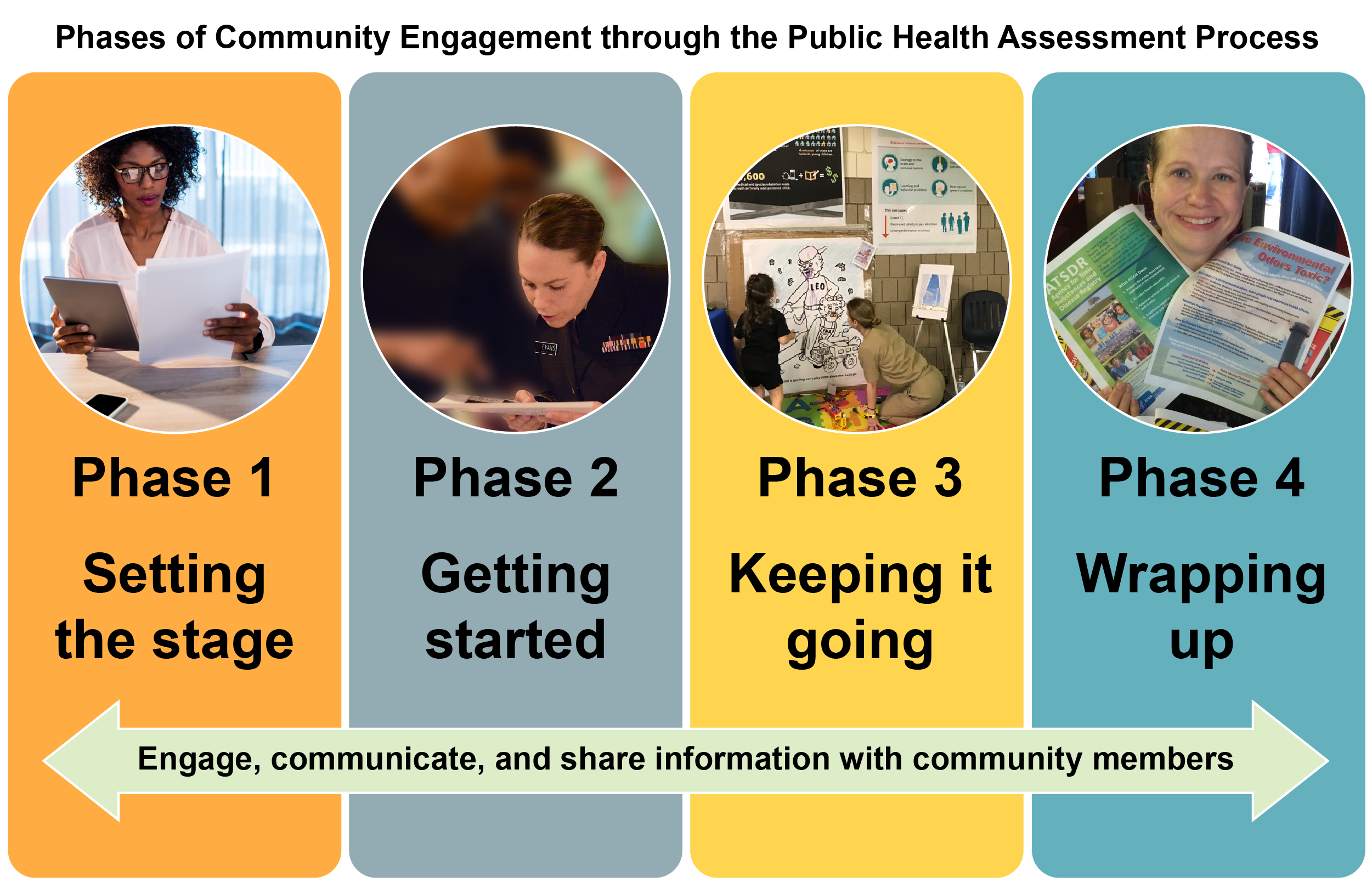Community Engagement Goals and Phases in the PHA Process
This section describes key objectives of community engagement and provides an overview of the main phases of community engagement during the PHA process.
One of the keys to the success of the PHA process lies in the ability of site teams to establish clear expectations, communicate effectively, and place the community at the center of its response. Community engagement will help you accomplish the following goals:
- Build trust, support, and open dialogue between community members and the ATSDR site team.
- Identify and understand the community’s health concerns and unique needs and preferences.
- Promote community participation in the PHA process.
- Obtain community support for taking actions that will protect them from harmful exposures to site-related contaminants.
- Engage new resources and allies.
- Address overall community health concerns and improve community health outcomes.
This section will cover the four phases of community engagement that occur during the PHA process and aligns with the ATSDR Community Engagement Playbook.
A first step in the PHA process is recognizing unique aspects of the community and planning for engagement. This includes gathering information about the site and the characteristics of the site community. This may include documenting site conditions (e.g., from site investigation reports), or community health concerns (e.g., from a petition letter). An important step in planning for engagement is recognizing whether an exposed or potentially exposed population is already experiencing economic or environmental burdens or social vulnerability.
Before you begin meeting with the community, take the time to learn about the community by performing online research and contacting community leaders to find out more about the site and how the site may be affecting the community, gather information about the community and its needs and concerns, and gauge the community’s stress level and interest in ATSDR’s work at the site. ATSDR’s Community Data Worksheet [PDF – 64 KB] is a good starting point for collecting all this information into a community profile. Through these initial activities, you will start to build an understanding of the community. The information you gather will also provide a foundation from which you can plan your subsequent community engagement activities.
As you reach out to community members, it is important to let them know what ATSDR can do and what the PHA process includes. It is equally important to notify community members early in the PHA process if their concerns are beyond the scope of ATSDR’s mission.
See more details about recognizing the community’s needs in the Understanding the Community section and planning for engagement in the Choosing Community Engagement Strategies section.
Once you’ve conducted initial research on the community, the next step involves visiting the community and establishing relationships with local leaders and residents. This is an important part of building trust and credibility in the communities. Suggestions about effectively communicating with and engaging communities can be found in the Effective Communication section.
It is important to develop a plan that provides a framework for successful community engagement. A community engagement plan is a very useful reference document to ensure an effective community engagement process is occurring with communities, tribes, and partners. The community engagement plan may include a detailed list of planned activities, timelines, and outreach strategies. This plan can be revised as needs and situations arise.
As the PHA process gets underway and continues, primary communication and engagement activities include:
- Updating the community on the PHA process status.
- Obtaining ongoing feedback on the process.
- Collecting additional information as needed or available from the community.
- Recommending public health actions, if needed, about how community members can protect their health.
The type and nature of the communication, education, and community engagement activities conducted during the PHA process may change over time and depend on the community’s needs and interests, public health issues identified at the site, site team capacity, available resources, and other factors [PDF – 205 KB].
There will often be a long period of time after meeting with the community at the start of an investigation and before a health assessor completes the evaluation to determine if a site poses a potential health hazard. Continuing engagement and communication and maintaining relationships with the community during this time is critical and should be ongoing throughout the PHA process. It is also a time to build local environmental health capacity in the community with activities including, but not limited to collaborating with community stakeholders and conducting environmental public health education.
Once your documents have been developed, it is time to communicate the key results, limitations, and recommendations to the community and other stakeholders. This is an important time to connect with the community and other stakeholders about ways they could be exposed to environmental contaminants, what exposure could mean for their health, and the actions and best practices to reduce exposure. This would also be a time to make communities aware of any expected follow-up activities.
If ATSDR or other stakeholders will be conducting any follow-up activities at the site (such as additional environmental sampling or health education), you may need to plan community engagement activities in conjunction with these actions.
The goal is to leave the community more informed and resilient than when the public health assessment process began.

Every community is unique in the nature and intensity of community health concerns and the availability of data to respond to these concerns.
The ATSDR Communication Toolkit (ACT) provides customizable tools for simplifying communication and responding to different levels of community concern.
The Community Engagement Planning Tool [PDF – 530 KB] is a flexible document that guides thoughtful planning and implementation of community engagement across the phases of public health work.
There are four key phases to community engagement associated with the PHA process, as shown in the figure below.

For detailed image description, click here.